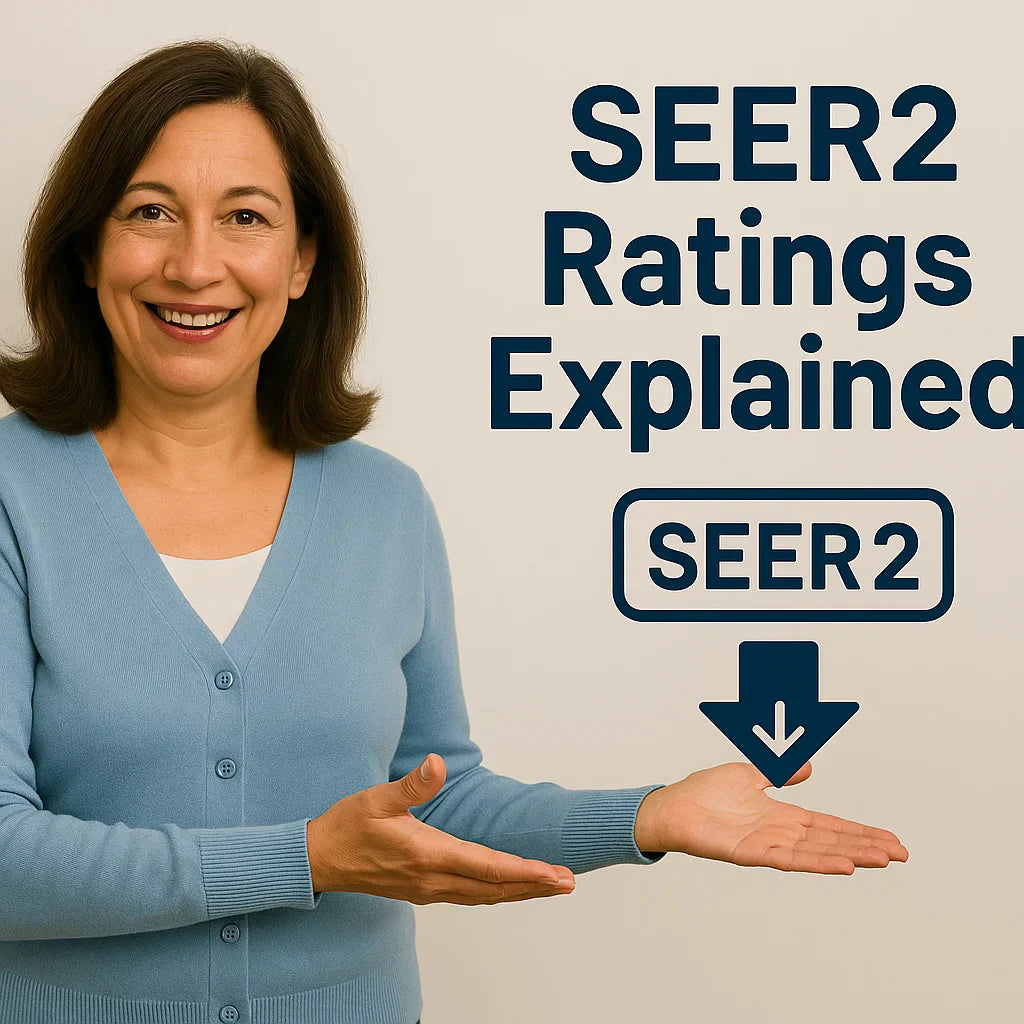🔍 Understanding the Basics: What Is SEER?
Before we dive into SEER2, it helps to understand the foundation: SEER (Seasonal Energy Efficiency Ratio). SEER measures an air conditioner's cooling efficiency over a typical cooling season.
The formula is:
SEER = Total Cooling Output (BTU) / Total Energy Input (Watt-hours)
In simple terms: the higher the SEER rating, the more cooling you get for each unit of energy consumed. A higher SEER translates to lower operating costs.
Historically, SEER ratings helped homeowners compare energy efficiency across different AC units. However, as testing standards evolved, a new metric was introduced to better reflect real-world performance: SEER2.
🔄 Why SEER2 Replaced SEER
🌿 A More Accurate Representation
Traditional SEER tests didn’t account for some real-world factors, like:
-
Higher external static pressure (airflow resistance in ducts)
-
Variations in climate zones
-
Variable load demands
The Department of Energy (DOE) introduced SEER2 starting January 1, 2023, to provide a more realistic measure of efficiency under real-world operating conditions.
🌿 Key Changes in SEER2 Testing:
-
External static pressure increased from 0.1" WC to 0.5" WC
-
Testing simulates actual ductwork resistance
-
More stringent performance expectations
Official Source: SEER2 Standards
🌎 The New Standard: 13.4 SEER2
🔢 What Does 13.4 SEER2 Mean?
A 13.4 SEER2 air conditioner, like the Goodman 3 Ton 13.4 SEER2 R-32 Air Conditioner Condenser (GLXS3B3610), meets or exceeds the minimum energy efficiency requirements set by the DOE for most of the U.S.
Here’s how 13.4 SEER2 compares to previous SEER ratings:
| Legacy SEER | Approximate SEER2 Equivalent |
|---|---|
| 14 SEER | 13.4 SEER2 |
| 16 SEER | ~15.2 SEER2 |
| 18 SEER | ~17.4 SEER2 |
This means that a 13.4 SEER2 unit performs similarly to an older 14 SEER unit under more realistic test conditions.
🕒 Regional Minimum Standards
The new standards vary slightly depending on where you live:
| Region | Minimum SEER2 (AC split systems) |
| North | 13.4 SEER2 |
| South & Southwest | 14.3 SEER2 |
Interactive Resource: Regional Efficiency Standards Map
💸 What 13.4 SEER2 Means for Your Utility Bill
🏠 Real-World Savings
The Goodman GLXS3B3610's 13.4 SEER2 rating offers solid efficiency for most homes, especially compared to older systems. If you’re upgrading from a 10 SEER unit (common for systems over 15 years old), you can expect up to 30-40% lower cooling costs.
📊 Sample Cost Savings Table
| SEER Rating | Annual Cooling Cost (Example) |
| 10 SEER (old) | $1,000 |
| 13.4 SEER2 | $700 |
| 16 SEER2 | $620 |
Note: Actual savings depend on usage, climate, and local rates.
🔡 Payback Period
Although higher-SEER models offer greater savings, they also cost more upfront. The Goodman GLXS3B3610 strikes an excellent balance between upfront cost and operational savings, often delivering a shorter payback period than more expensive high-SEER models.
🔧 How Goodman Optimizes for 13.4 SEER2
Goodman engineered the GLXS3B3610 specifically for the SEER2 standard:
-
R-32 refrigerant (high heat transfer efficiency)
-
Optimized heat exchanger coil design
-
High-efficiency scroll compressor
-
Advanced control boards for better airflow management
By tailoring these components, Goodman ensures the unit performs optimally under the new, more demanding SEER2 test conditions.
Further Reading: Goodman SEER2 Product Line
🌍 Environmental Benefits of SEER2
🌿 Reduced Carbon Footprint
Higher efficiency units reduce your home’s greenhouse gas emissions, especially when paired with low-GWP refrigerants like R-32.
🚗 Nationwide Energy Savings Impact
DOE projections estimate the 2023 SEER2 standards will save 2.2 quadrillion BTUs of energy and cut CO2 emissions by 132 million metric tons by 2030.
Official Study: DOE Energy Savings Impact Analysis
🤝 Who Should Choose 13.4 SEER2 Units?
📅 Best Fit For:
-
Moderate climates
-
Budget-conscious homeowners
-
Smaller or well-insulated homes
-
Homeowners replacing older low-SEER units
⚠️ Consider Higher SEER2 If:
-
You live in very hot climates
-
You expect extremely high cooling demands
-
You want maximum long-term energy savings
Goodman offers higher SEER2 models for those scenarios, but for many homeowners, 13.4 SEER2 offers excellent value.
Goodman Comparison Guide: Choosing the Right Goodman SEER2 Unit
🔔 Common Myths About SEER2
🔈 Myth 1: "Higher SEER2 always means better."
Not always! Higher SEER2 models cost more upfront. The right choice balances purchase price, climate, usage patterns, and payback period.
🔈 Myth 2: "SEER2 doesn’t really matter if I maintain my old unit."
Older units become less efficient over time, and refrigerant phase-outs make repairs costly. Upgrading ensures better performance, lower bills, and regulatory compliance.
🔈 Myth 3: "SEER2 ratings aren’t that different from old SEER."
SEER2 uses stricter testing conditions that reflect actual performance much better than the old SEER tests.
🔢 How to Calculate Your Personalized Savings
🎯 1. Use an Online SEER Savings Calculator
Many tools allow you to enter your:
-
Current SEER rating
-
Planned SEER2 rating
-
Local utility rates
-
Cooling hours per year
Example: Energy Star SEER Calculator
🎯 2. Consult with Your HVAC Contractor
Local professionals can factor in:
-
Ductwork condition
-
House insulation levels
-
Climate zone demands
-
Utility rebate programs
💼 Summary: SEER2 Is Raising the Bar
The shift to SEER2 represents a major step forward for residential HVAC systems. With its 13.4 SEER2 rating, the Goodman GLXS3B3610 offers homeowners:
-
Solid energy savings
-
Lower environmental impact
-
Future regulatory compliance
-
Reliable Goodman performance and warranty protection
For many families, it's the perfect sweet spot of affordability, efficiency, and long-term value.
In the next topic we will read about: Is a 3 Ton Air Conditioner Right for Your Home? Sizing, Load Calculations, and Common Mistakes







